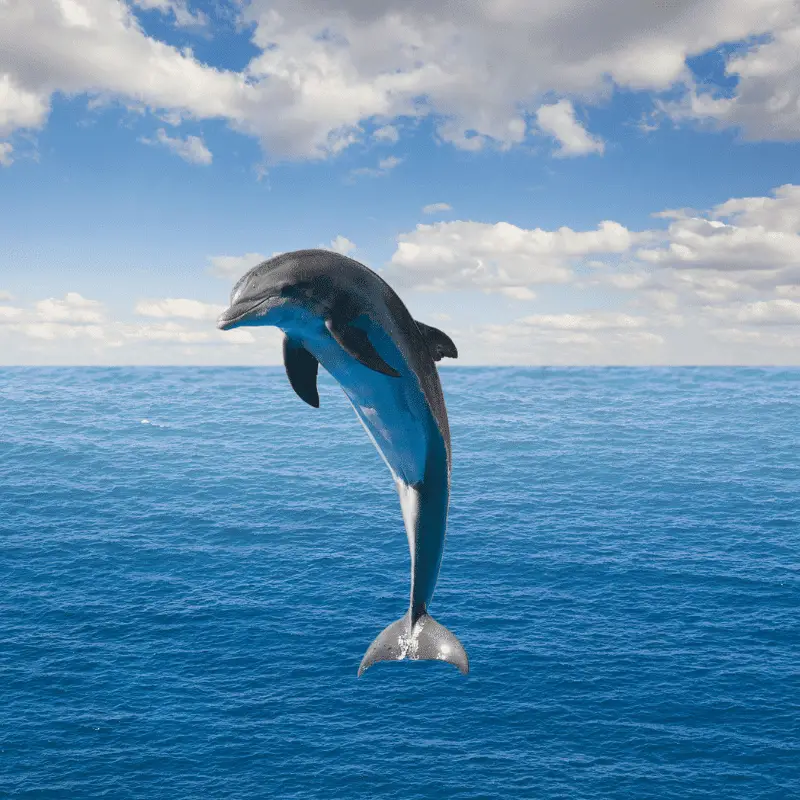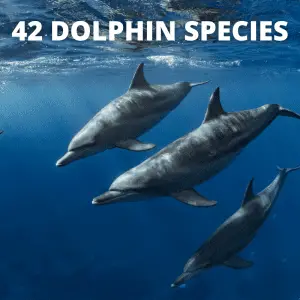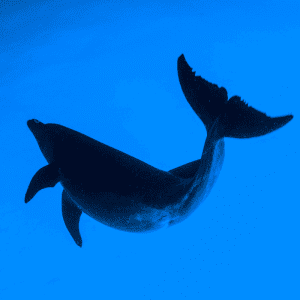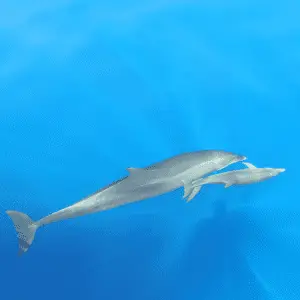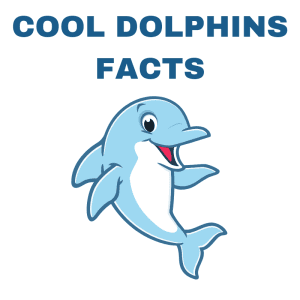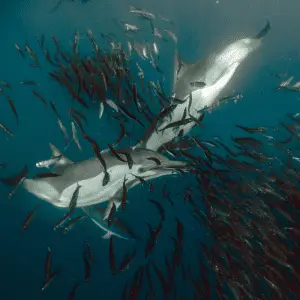ANSWER: A female dolphin is called a cow.
Even though dolphins are aquatic animals, they are not fish. Instead, dolphins are mammals, and the males and females are called bulls and cows, like many other mammals. As below
| Animal (Mammal) | Male Name | Female Name |
|---|---|---|
| Alligator | Bull | Cow |
| Bison | Bull | Cow |
| Camel | Bull | Cow |
| Caribou | Bull | Cow |
| Dolphin | Bull | Cow |
| Elephant | Bull | Cow |
| Elk | Bull | Cow |
| Gnu | Bull | Cow |
| Hippopotamus | Bull | Cow |
| Manatee | Bull | Cow |
| Moose | Bull | Cow |
| Ox | Bull | Cow |
| Porpoise | Bull | Cow |
| Reindeer | Bull | Cow |
| Rhinoceros | Bull | Cow |
| Sea Lion | Bull | Cow |
| Seal | Bull | Cow |
| Walrus | Bull | Cow |
| Whale | Bull | Cow |
| Yak | Bull | Cow |
The baby dolphins are known as calves. After birth, the babies become entirely dependent on their mothers’ milk. Milking is the most blatant proof that dolphins are mammals and not fish.
Evolution of The Dolphins
Dolphins are mammals, and they are the direct descendants of land-dwelling mammals of the Artiodactyla order. The dolphins split up from an animal of this order known as Indohyus about 48 million years ago. About 5 to 10 million years later, the primitive cetaceans became fully aquatic. Today the closest living terrestrial animal to dolphins are the hippopotamuses. These animals share a semi-aquatic predecessor that branched off from the Artiodactyla order about 60 million years ago.
Recommended Read: What animal did dolphins evolve from?
Why Dolphins Are Not Fish
Even dolphins can swim in the water as gracefully as fish. They are not related to them. Instead, dolphins are aquatic mammals that branched off from an order of terrestrial mammals about 48 million years ago. Dolphins have all the general characteristics that mammals have. For example, dolphins breathe through their lungs, not having any gills. These marine animals are warm-blooded and give birth to live young.
The word warm-blooded means that dolphins can regulate their body temperature. They can keep quite warm even if the water temperature drops significantly around warm.
Take the dolphin living in the North Pacific Ocean region; for example, the ocean is situated in the Arctic region ion, and the water can freeze. However, the dolphins in this area do not face any problems thanks to their warm-blooded body.
This single physical characteristic helps the dolphins to survive in this extremely harsh environment. As these animals are warm-blooded, they are also less susceptible to infections and severe health conditions from which cold-blooded species suffer the most.
Another physical feature differentiating the dolphins from the rest of the fish and other marine animals is their lungs instead of gills. That means dolphins, like whales and hippos, cannot breathe underwater.
They must periodically come up to the water’s surface to replenish their oxygen supply. the whales, and dolphins also have blowholes on the top of their head to control their breathing.
The dolphin can shut off the blowhole entirely whenever it tries to dive underwater. The dolphins only open their blowholes when they reach the water’s surface.
There is another method by which dolphins have secured their survival in the water. For example, dolphins can exchange 80% of their air with the help of their lungs. Compared to that, humans can only exchange about 17% of air effectively when they breathe.
The dolphins also have an immense oxygen storage capacity in their blood, lungs, and muscles. All of these have helped the dolphins remain underwater for an extended period. On average, dolphins can keep underwater without breathing for about ten minutes.
Are orcas fish?
No, they are not. Orcas are dolphins. They are mammals and the largest member of the dolphin family.
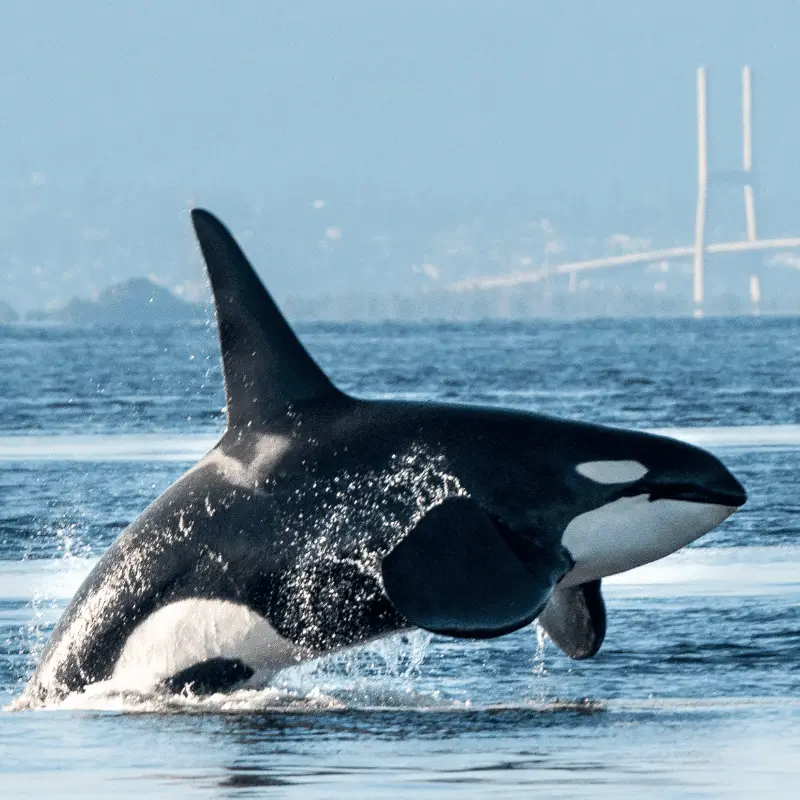
Why are killer whales called killer whales?
Their real name is Orcas, also known as the Killer whale, which got the name by accident. A group of orcas were discovered killing other whales many years ago and given the name of whale killer. Nowadays, the name has been flipped to the killer whale, which suggests it’s a whale; however, these mammals are in the same Delphinidae family group as the dolphins.
9 Dolphin Facts
- Dolphins are marine mammals, and they do not lay eggs.
- Every two to four years, female dolphins can get pregnant.
- The baby dolphins tend to depend entirely on the mother’s milk for the first couple of months.
- Dolphin mothers are excellent teachers that teach the baby dolphins all the tricks they need to survive in the ocean.
- Most dolphin babies become independent and leave their mothers when they are about 3 to 4 years old.
- Dolphins do not have breasts in the traditional sense, but they nurse their young.
- The gestation period of the dolphins lasts for about 12 – 18 months.
- Dolphin milk is a very oily and thick paste-like substance.
- Dolphin babies feed underwater.
Do dolphins have fur?
Dolphins don’t have fur. However, baby dolphins have hair on their beaks, which falls out soon after birth. It is thought that this hair is a remnant from when the ancestors of today’s dolphins lived on land.
Are Dolphins Intelligent?
Dolphins are perhaps one of the most intelligent animals in the wild. The intelligence level of the dolphins is second to only the humans. Dolphins have several cerebral cognitive abilities to prove this. The intelligence of the dolphins is a unique combination of communication perception and problem-solving ability. You can tell that dolphins are extremely intelligent mammals by observing how they interact with each other.

